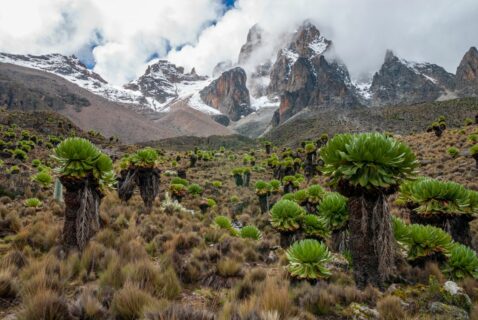Africa’s ice is disappearing
Tropical ice fields demonstrate speed of climate change
The few glaciers in Africa have long since become an important indicator of how rapidly and severely climate change is changing our planet. The ice on the high summits of the continent is rapidly disappearing, Africa may lose its white peaks by the middle of our century. The Master’s student Anne Hinzmann and her supervisors Prof. Dr. Thomas Mölg and Prof. Dr. Matthias Braun at the Institute of Geography at FAU together with the universities in Otago in New Zealand, Massachusetts in the USA and Innsbruck in Austria have published their findings showing how quickly glaciers there are shrinking in the journal Environmental Research: the ice fields in Africa have more than halved since the beginning of the 21st century.
With their study, the group has closed a gap. As Anne Hinzmann explains, “we did not have any accurate data from previous years.” The area of the glacier on the 5199 meters high Mount Kenya in the state of the same name was last measured precisely in 2016, comparable data concerning the 5985 meters high Kilimanjaro in Northern Tanzania was only available from 2011, and the area of the glacier in the 5109 meters high Ruwenzori Mountains at the border between Uganda and the Democratic Republic of Congo had not been measured since 2005.
These three unique glacial regions in Africa are particularly interesting as they are located in the middle of the tropics, not far from the Equator. Ice only forms there under natural circumstances because the summits are very high, and therefore in cold regions. If the ice recedes there, then this should not be in direct correlation to rising temperatures in these areas, unlike the case, for example, in the Alps in Europe.
What has changed in this region is precipitation, as discovered several years ago by researchers including FAU researcher Prof. Thomas Mölg and his group. In East Africa, precipitation falls mainly during two rainy periods from October or November until December and from March until May, while it remains dry most of the rest of the time. Only a small part of the heavy precipitation in the rainy periods reaches the high levels. There, it falls as snow.
If the average temperatures at the high altitudes of Kilimanjaro, Mount Kenya and the Ruwenzori Mountains remain below freezing, this snow stays lying and is covered with a new white layer at the latest in the next rainy period. In time, more and more snow presses down on the deeper layers, pressing the lowest layers into ice and causing a glacier to form. If precipitation decreases, the ice does not become replenished and the glacier starts to retreat. The rainy periods have started to become drier since the end of the 19th century, and since then, the glaciers have started to shrink. FAU student Anne Hinzmann wanted to find out how quickly this process is progressing by using high resolution satellite images taken daily of each area. “However, not every image is suitable for us to use,” Anne Hinzmann explains. For example, clouds often form over high mountains in warm climates and block the view of the ice masses. However, analyzing the data is also relatively complicated even when the sun shines, as for example snow fields have to be differentiated from ice fields and because the shade cast by the sun, particularly when it is low in the sky, distorts the images.
After analysis, however, the data paint a drastic picture. “Since the glaciers were mapped for the first time at the turn of the century between the 19th and the 20th century, more than 90 percent of their area has disappeared,” explains Anne Hinzmann. In 1899, Mount Kenya still had an area of 1.64 square kilometers, but this had shrunk to 0.07 square kilometers in 2021/2022. In the Ruwenzori Mountains, the ice has shrunk from 6.51 square kilometers in 1906 to just 0.38 square kilometers, and even the largest area of ice in Africa on Kilimanjaro decreased from 11.4 square kilometers in 1900 to 0.98 square kilometers between 2021 and 2022. The climate indicators of the glaciers in the tropical regions do not only show that climate change has long since started, it also shows that it is progressing at a breakneck speed. “A decrease at this scale is alarming,” according to FAU researcher Anne Hinzmann. “The glaciers in Africa are a clear indicator of the impact of climate change.”
The changes in precipitation in the region play an important role. There are not only fewer rain clouds, there are also more days with no clouds at all, thereby exposing the glaciers to more sunshine. Even if the temperatures remain below zero, the sun can change the ice directly into water vapor and humidity, gnawing away at the glacier as a result. This does not happen evenly. In dips there is less sun and the ice remains longer in such protected positions. It is similar for glaciers on western slopes, which may be exposed to a lot of sun in the afternoons, but are more often covered by cloud than other areas. They are exposed to less energy from the sun and the ice is attacked more slowly. Apart from such cases, the few ice fields in the tropics show particularly clearly just how fast climate change is already progressing today.
Further information:
DOI: https://doi.org/10.1088/2752-5295/ad1fd7
Anne Hinzmann
anne.hinzmann@fau.de
Prof. Dr. Thomas Mölg
Professorship of Climatology
thomas.moelg@fau.de
Prof. Dr. Matthias Braun
Professorship for Geography (Remote Sensing and GIS)
matthias.h.braun@fau.de
